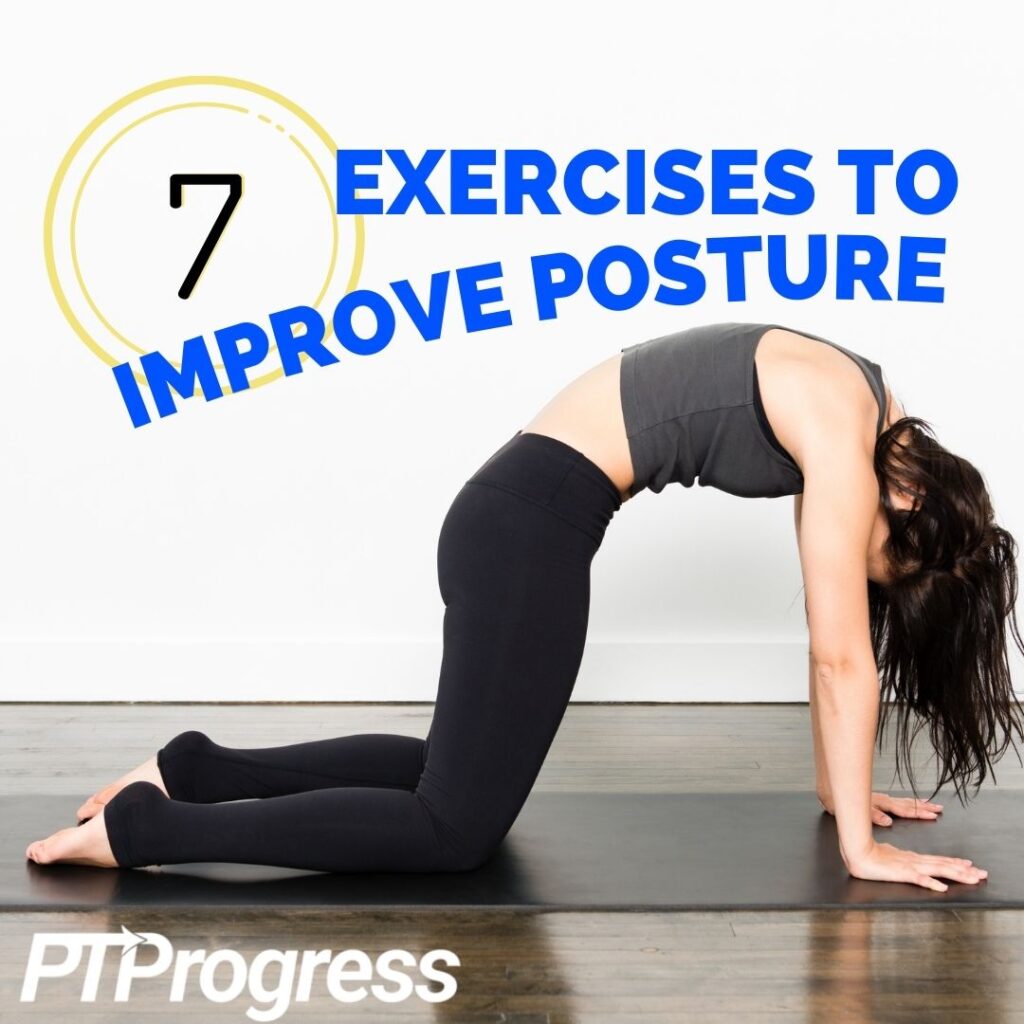If you’re like any of my patients, your poor posture includes a forward head, rounded shoulders, and a bowed back.
But don’t worry – this can change! Stretching will improve the range of motion and decrease tension in your body, while exercise will strengthen the muscles that are clearly too weak to maintain proper posture.
Below are 7 exercises to help fix bad posture, exercises I know will deliver results!
7 Exercises to Fix Bad Posture
1. Countertop thoracic extension stretch
I put this exercise first because it’s easy, and you can do it nearly anywhere without equipment. All you need is a countertop!
There are two ways to perform this exercise. The first way is to place your elbows on the countertop and flatten your mid back as much as possible as you rock back slightly. Hold for 15-20 seconds, or rock back and forth. You should feel a stretch along your lats and mid back.
The second way is to place both hands on the counter with arms extended, then rock back and hold as before. Don’t be surprised if your mid-back cracks; it’s a common and cathartic result of this extension. Some of these exercises will almost always result in that mid-back self-manipulation which many people like.
You can also angle this stretch by placing one hand on top of the other and shifting your weight to the side opposite your hands.
No matter how you perform this thoracic extension, aim for 10 reps of 15-second holds.
2. Reverse Wall Slide
The reverse wall slide (aka “wall angel”) is perfect for improving your posture. Not only does it actively stretch the pecs, it also incorporates thoracic extension and scapular mobility in one move.
To perform the exercise, stand with your back flat against a wall (no arching!). Hold your arms up at shoulder height like goal posts, keeping your thumbs as close as possible to the back wall. Now slide your arms up the wall while maintaining a flat spine and stable neck.
With a little resistance, you can make this exercise even more effective for strengthening the scapular stabilizers. Grab a resistance band and hold it behind your back, under your armpits. Now resume your wall angels, and you’ll feel the band resist the motion as you extend your arms up the wall.
Band or no band, aim for 15-20 wall angels 3 or 4 times a day.
3. Thoracic Mobility Drills
This exercise accommodates a variety of positions, but my go-to setup for the thoracic mobility drill is against a chair.
In order to create a hinge point, position a towel or a ball along the top of the chair. Sit in the chair and align your mid-back against the towel.
Cross your arms in front of you and stretch back, over the towel. Hold the position briefly before returning to your start position. Try repeating this movement 20 times.
Instead of crossing your arms, you can also stack your hands behind your head for a deeper stretch.
Throughout the movement, you may feel your range of motion start to increase, and your spine might even pop a little. Doing this drill every day will help relieve back tension and improve long-term thoracic mobility.
4. Thoracic Extension over a Foam Roller
Thoracic mobility is essential for fixing bad posture and relieving upper back pain. So this exercise takes the previous drill a step further by using a foam roller (an inexpensive tool I highly recommend). If you don’t have a foam roller, a rolled-up towel will do.
Place your foam roller or towel horizontally on the floor and lie down so that it’s directly beneath your shoulder blades. Just as you did before on the chair, stack your hands behind your head, elbows wide, and stretch your back over and around the foam roller.
You can hold the position for 20 to 30 seconds or repeat the movement 15-20 times. Once you’ve found a good stretch, inch the foam roller gradually up and down your spine. As you work on different areas of your back, you’ll feel some of those tight spots start to loosen up.
This is a great movement to incorporate throughout the day as a way to extend your mid-back. You’ll also achieve cathartic self-manipulation of the thoracic spine (i.e., back cracks!) as you stretch over the foam roller.
5. Cat/cow stretch
This exercise is best done on hands and knees, but if that’s uncomfortable for you, modify it by placing your arms on a countertop instead.
To perform a cat/cow stretch, you’ll alternate between two positions. First, round your back like an angry cat and tuck your chin to your chest. Then switch to the “cow” by raising your head and arching your back. Alternate cats and cows to actively flex and extend your thoracic spine.
The cat/cow stretch will help you reverse your rounded back posture by engaging and strengthening the upper paraspinals and scapulothoracic musculature. But you don’t need to worry about those terms – you’ll feel the difference in your back after doing this stretch throughout the day!
Aim to perform 15 to 20 cat/cows before moving on to the next exercise.
6. Prone Press-Up
For many of my patients, the prone press-up is a challenging exercise, so let’s focus on the start position first.
As adults, we don’t spend a lot of time lying “prone,” or lying on the stomach, propped up on elbows. But the prone position is a welcome change for your spine from the rounded-shoulders posture you’re eager to change.
It’s essential that you get this prone position right before adding the press-up. Lie down on your stomach with your elbows beneath your shoulders. To extend your upper spine, slowly press up with your elbows.
Try to avoid hinging entirely through your lumbar spine. Instead, aim for a slight arch in your lower back and imagine rolling your body off the ground, like you’re peeling yourself off the floor.
From here, you can hang out – read a book, check your phone – or simply count to 30. You can also work into this position gradually as an active stretch (halfway up, halfway down). When you’re ready for a deeper stretch, press your hands on the ground and start to straighten your arms, lifting your head up as you gradually invert your back.
To make this full press-up an exercise, shift between bent elbows and straight arms. You can flow right into this from a cat/cow stretch.
Again, for most people, holding this position is a challenge, so work into it gradually. If you’re just starting out, shoot for 10- to 20-second holds with 5 to 10 repetitions. Your next goal can be holding for 30-60 seconds, and then a whole commercial break…and so on, as long as it’s comfortable.
7. 3-Way Diagonals
This is one of my favorite exercises to help fix poor posture. It strengthens the rotator cuff, encourages thoracic extension, and targets the supporting muscles of the mid-back, such as the middle and lower trapezius.
For this exercise, you’ll need a resistance band. (I recommend checking out this set of bands from my buddies Bob and Brad.) Holding onto either end, stretch the band diagonally across your chest, then switch direction. To target even more muscles of the shoulder, stretch the band horizontally across your chest.
Some tips on technique: hold the band with your thumb pointing towards the ceiling and relax your neck. As you stretch the band, squeeze your shoulder blades together.
Try to perform at least 10 rounds of this 3-way move, totaling 30 movements.
Your arms will certainly get tired by the end, but as long as you’re minding your form, keep it up! When done consistently, this exercise will help you build strength and endurance in your back muscles.
Plus, if you have the whole set of bands, you can always scale down the resistance to amp up your reps.
You CAN Fix Bad Posture!
Fixing poor posture isn’t as hard as it sounds. In fact, some of these exercises are fun to perform, and are a welcome relief from sedentary living.
Just pay attention to your body as you exercise and stretch, backing away from any pain or sharpness. In time, the more you work on these thoracic mobility and strengthening exercises, the straighter your posture will be!


